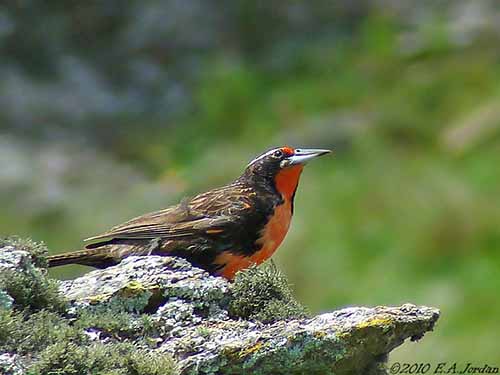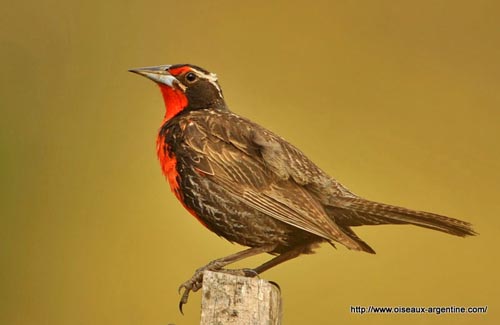
Fr: Sturnelle australe
All: Langschwanzstärling
Esp: Loica Común, Loica, Pecho colorado grande, Turpial de Cola Larga
Ita: Sturnella allodola codalunga
Nd: Grote Weidespreeuw
Sd: Långstjärtad ängstrupial
Photographers:
John Anderson
John Anderson Photo Galleries
Jean Michel Fenerole
Photos d’Oiseaux du monde
Eduardo Andrés Jordan
MIS AVES – AVES DE ARGENTINA
Otto Plantema
Trips around the world
Philippe et Aline Wolfer
GALERIE
Text by Nicole Bouglouan
Sources:
HANDBOOK OF THE BIRDS OF THE WORLD Vol 16 by Josep del Hoyo- Andrew Elliot-David Christie – Lynx Edicions – ISBN: 9788496553781
NEW WORLD BLACKBIRDS – THE ICTERIDS by Alvaro Jaramillo and Peter Burke – Helm - ISBN : 0713643331
BIRDS OF SOUTH AMERICA – Passerines - by Robert S. Ridgely and Guy Tudor – HELM Field Guides – ISBN: 9781408113424
BirdLife International (BirdLife International)
Animal Diversity Web (University of Michigan Museum of Zoology)
Long-tailed Meadowlark
Sturnella loyca
Passeriformes Order – Icteridae Family
INTRODUCTION:
The Long-tailed Meadowlark is a South American Icteridae species, present in Chile, Argentina and Falkland Islands. Very similar to other red-breasted meadowlarks, it differs from them by its long tail. This bright-coloured bird is often seen perched on fences from which the male sings loudly during the breeding season. This species is common throughout its range.
DESCRIPTION OF THE BIRD:
Biometrics:
Length: 25-27 cm
Weight: M: 112 g – F: 97 g
The adult male in breeding plumage has blackish-brown upperparts with paler feather edges involving brown-streaked appearance. The rump is browner with brown tips to feathers. The uppertail-coverts are olive-brown barred black. The tail is blackish with olive-barred rectrices.
On the upperwing, the marginal coverts along the inner part of the leading edge are pinkish-red, most visible on the bend of the wing, and sometimes in flight. The coverts form a pale panel on closed wings, due to dark feathers and white fringes. The flight feathers are darker.

The underparts are largely pinkish-red from chin to upper belly. The black flanks, thighs and belly show pale fringes, broader on thighs and belly. The undertail-coverts are black with white fringes. The underwing has pale greyish-white coverts. The undertail feathers are blackish.
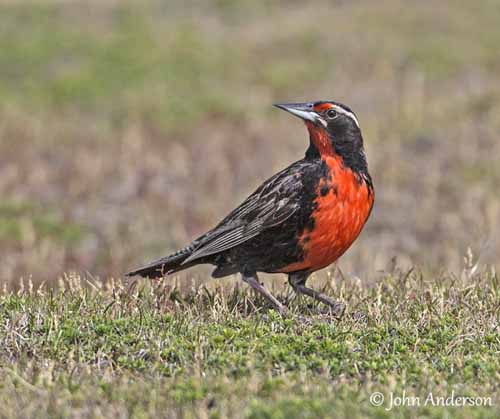
On the head, the crown is blackish streaked brown, with pale brown median stripe. There is a conspicuous white supercilium extending towards the nape which is streaked black and pale brown. We can see a pinkish-red supraloral area above the black lores. The ear-coverts are black with thin pale fringes. There is a short, white malar stripe.
Chin and throat are pinkish-red and join the similar underparts. The black of the face extends down to the breast sides. Neck sides are blackish with pale streaks.
The long, pointed bill is silvery-grey with dark tip and culmen. The eyes are dark brown, surrounded by narrow, feathered, white eyering. Legs and feet are brownish-grey.
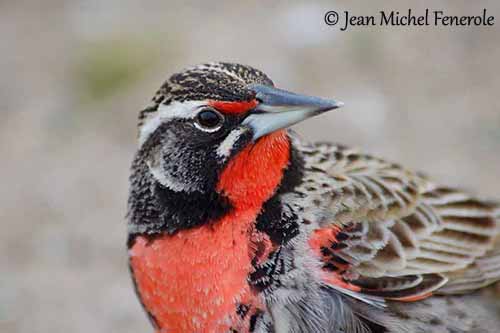
The male in non-breeding plumage has the red underparts obscured with buff-tipped feathers, and the pattern of the upperparts appears crisper.
The female resembles male but she is browner, with red on the underparts restricted to belly. The breast is streaked brown like the flanks. Chin and throat are white. The white supercilium may become pinkish in the supraloral area. She is slightly smaller than the male, with shorter tail.
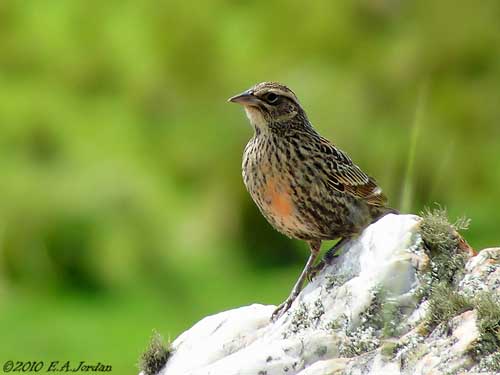
The juvenile resembles female but it has only a reduced pink patch in breast centre. Scapulars and tertials have scaly appearance. The breast is more densely streaked.
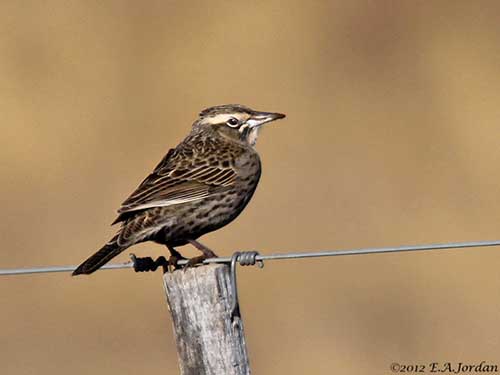
SUBSPECIES AND RANGE:
Four subspecies are recognized.
S.l. catamarcana can be seen locally in the highlands of Argentina. This race is paler than nominate.
S.l. loyca (here described) is found in Chile (S to Cape Horn) and Argentina (S to Tierra del Fuego).
S.l. obscura occurs in C Argentina. This one is darker than nominate.
S.l. falklandica is found in the Falklands. This one has longer bill, slightly wide at tip, and we can see some white on the outermost rectrices.
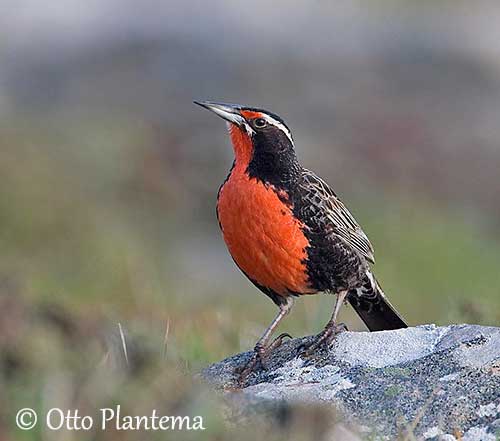
HABITAT:
The Long-tailed Meadowlark frequents grasslands in open areas, fields, pastures, Andean grasslands, Patagonian steppes and meadows with tussac grass.
In the Falklands, it can be seen in grasslands near the shores, heathlands, tussac grass with clearings of short turf, and generally in open areas.
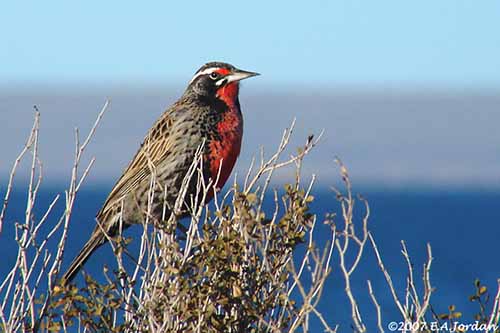
CALLS AND SONGS: SOUNDS BY XENO-CANTO
The Long-tailed Meadowlark often sings from perch. The male’s song is usually louder than that of the female. The song is loud and wheezy. It starts with a series of short whistles which differ for long and short songs.
The longer song (at least two seconds) consists of series of short whistles, followed by two longed modulated whistles with one rising and the other falling (or vice versa), and ending in a whine.
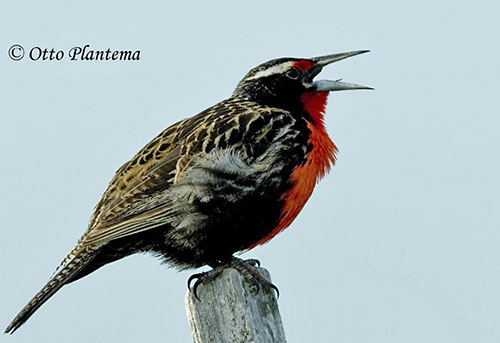
The race “falklandica” utters a song while flying and gliding over the territory. This song is more complex than in other subspecies.
The calls “peet” or “pimp” are given by both sexes, and a short “twick” can be heard too.
The race “falklandica” utters an explosive “cheeoo” in flight. While foraging, some “chook” or “chink” are given. This race can be seen singing from the ground.
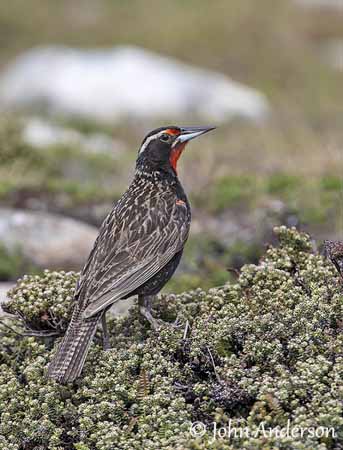
BEHAVIOUR IN THE WILD:
The Long-tailed Meadowlark forages mainly on the ground where it can find seeds and arthropods, mainly insects. Some fruits can be eaten sometimes.
In the Falklands, it takes numerous invertebrates including worms, grubs, beetles and caterpillars. Marine invertebrates are taken too while foraging on the shore.
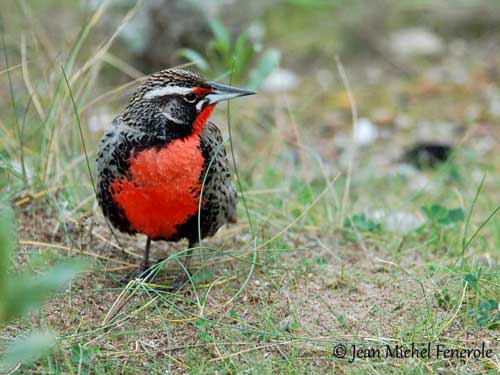
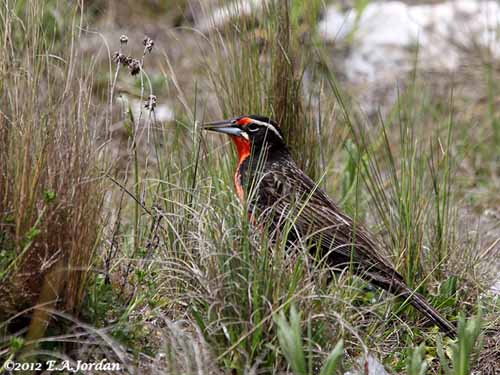
The Long-tailed Meadowlark uses perches for calling and in territorial display. They occur in flocks of up to 50 birds outside the breeding season, but in territory defence, they can become aggressive. Aggression with physical attack is observed. Face-off and jump-flight may involve hostile and intense encounters with song duetting and flight-song duetting.
The Long-tailed Meadowlark is monogamous. It does not perform display flight like other meadowlarks. The courtship displays are not described for this species, but numerous males Icteridae display from perch with lowered head, raised body feathers and spread wings and tail. These displays are accompanied by songs, and enhance the bright colours of the underparts and the head pattern.
The Long-tailed Meadowlark nests on the ground or in low, dense vegetation. In the Falklands, the nest is placed one metre above the ground, in a clump of grass Poa flabellata.
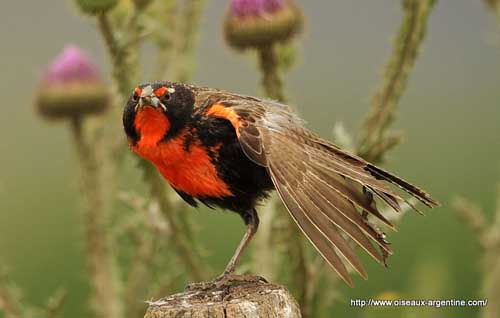
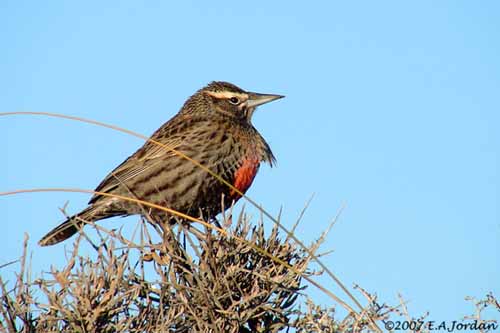
The Long-tailed Meadowlark is mainly resident in its range, but some Patagonian birds move N into Córdoba and Buenos Aires. The birds of S Chile also move N to the central regions. The populations of Tierra del Fuego and Falklands are resident.
The flight is strong and direct.
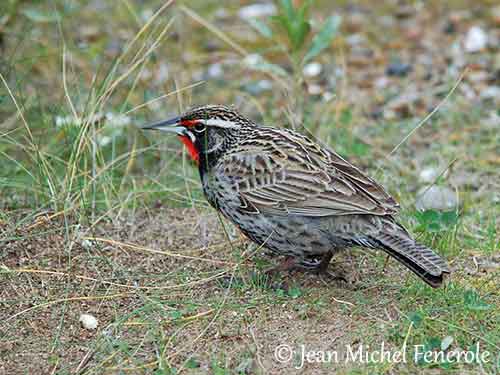
REPRODUCTION OF THIS SPECIES:
The breeding season varies depending on the range. It occurs between September and January on the continent, whereas in the Falklands, the laying occurs from August to December.
The nest is placed on the ground and is built by the female. She makes a cup with grass stems, and she may add a partial domed roof. There is a tunnel entrance which can reach sometimes one metre long.
In the Falklands, the nest is about one metre above the ground, often in clump of tussock grass, or hidden among the vegetation or gorse.
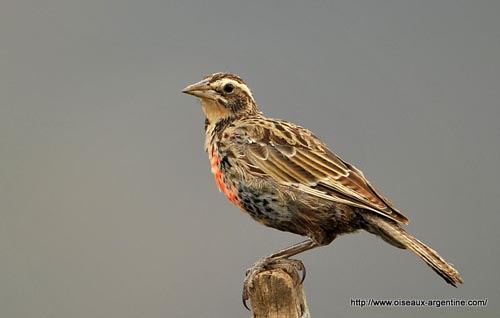
The female lays 3-5 buffy to greyish eggs with dark spots. The incubation lasts 10-12 days, mainly by female while the male protects the nest-site. The chicks are fed by both parents, and fledge 15 days after hatching, but they still depend on adults for two weeks.
The duration of incubation and fledging period is similar in the Falklands.
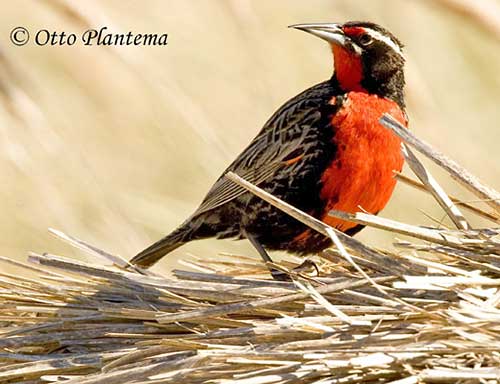
PROTECTION / THREATS / STATUS:
The Long-tailed Meadowlark has wide range in which it is common and fairly widespread. In spite of predation by raptors and feral cats, and brood-parasitism, the populations appear stable.
The race “falklandica” is widespread in most of the islands, and the population is estimated at 10,000 breeding pairs. The global population is unknown.
The Long-tailed Meadowlark is not currently threatened and evaluated as Least Concern.
